The Nexus 7 (2013) Review
by Anand Lal Shimpi on August 22, 2013 6:00 PM EST
Truth be told, Google has made (or at least directed the making of) some of the best tablets on the market today. The original Nexus 7 was groundbreaking in that it offered a totally usable platform, married to the latest version of Android, for $199. The Nexus 10 gave us a very quick, ultra high resolution 10-inch tablet for $100 less than the flagship iPad (and with more storage). Both were easily recommendable due to their value, but this year Google is stepping out of the shadow of value and into one of excellence. It starts with the new Nexus 7.
Based on the success of the original Nexus 7, Google went back to ASUS for the second version. In the 12 months since the release of the Nexus 7, the world has changed quite a bit. Expectations for value tablets had been reset by the original Nexus 7 as well as Amazon's lineup of Kindle Fires. Simply showing up with another good value likely wouldn't do anything to further the brand (or market). I get the distinct impression that Google isn't big on not changing the world.
| Nexus 7 Tablet Specification Comparison | ||||
| ASUS Nexus 7 (2012) | ASUS Nexus 7 (2013) | |||
| Dimensions | 198.5 x 120 x 10.45mm | 200 x 114 x 8.65mm | ||
| Chassis | Plastic + Rubber back | Plastic + Soft Touch back | ||
| Display | 7-inch 1280x800 IPS | 7.02-inch 1920x1200 IPS | ||
| Weight | 340 g | 290 grams (WiFi), 299 grams (LTE) | ||
| Processor | 1.3 GHz NVIDIA Tegra 3 (T30L - 4 x Cortex A9) | 1.5 GHz Qualcomm Snapdragon S4 Pro (APQ8064-1AA) | ||
| Memory | 1 GB | 2 GB DDR3L | ||
| Storage | 8 GB / 16 GB | 16 GB / 32 GB | ||
| Battery | 16 Whr | 15.01 Whr | ||
| WiFi/Connectivity | 802.11b/g/n, BT, NFC | 802.11a/b/g/n, BT 4.0, NFC | ||
| Camera | 1.2MP Front Facing |
5.0 MP Rear Facing w/AF 1.2MP Front Facing |
||
| Wireless Charging | – | Yes (Qi Compatible) | ||
| Pricing | $199/$249 |
$229/$269 (WiFi 16/32 GB) $349 (LTE) |
||
The result is the new Nexus 7. Identical only in name, manufacturer and screen size, the 2013 Nexus 7 is a downright Apple way to rev a product. Google made it thinner, lighter, faster and better in almost every way.

2013 Nexus 7 (left) vs. 2012 Nexus 7 (right)
The original Nexus 7 was rather thick but it got away with it since the overall footprint of the tablet was so small. The new Nexus 7 truly feels like a slate. It's the type of thing I expect to see carried around on the Enterprise.
I don't miss the rubber imitation leather from the original Nexus 7, it's replaced by a soft touch plastic back. You definitely don't get the premium aluminum feel of the iPad mini, but the device doesn't feel cheap either. The new Nexus 7 is still nice enough that I'm nervous about scratching or scuffing the back.
Both ASUS and Nexus logos are prominently featured on the back. ASUS continues to amaze me by just how far it's come as a company, and the new Nexus 7 is hands down its most impressive tablet creation yet. From a build quality standpoint I really have no complaints about the Nexus 7. While the MeMO Pad HD7 has some creaks and flex in the chassis, the new Nexus 7 feels like a solid slab of soft plastic and glass. It's nice.
Unlike the original Nexus 7, the new model features stereo speakers on back of the tablet. It's an easy feature to take for granted but going back to the old mono design sounds worse.
I agree with Brian that the power/lock and volume buttons are the only real sore spot on the physical execution. They aren't particularly well defined and feel a bit mushy. Even writing this paragraph feels like I'm nit picking though, the build here is really good.
The only other complaint I'd levy against the new Nexus 7 is that the design doesn't particularly stand out as being unique. The iPad has its aluminum, the Moto X has its wood, but the Nexus 7 falls victim to the fact that ultimately it's tough to make these ultra mobile devices stand out. You need a large glass surface and you need a back. Black also tends to be one of the easier colors to sell (get too creative and you end up with inventory problems). It's not a huge deal to me personally, but as mobile devices can often be fashion statements I don't know that the new Nexus 7 has all that much curb appeal.
The Display
What the Nexus 7 lacks in pizazz, it completely makes up for once you power on the display. The 7-inch 1920 x 1200 display produces colors that are not only vibrant but, for the first time ever in a Nexus device, accurate as well. Google really worked on color accuracy this time, with a two step calibration process - once at a high level by the panel maker and once again per device during final manufacturing. The result is just awesome:
The Nexus 7 display is not only visually appealing but stacks up incredibly well in our CalMAN display tests. Although it loses to the iPad 4, the Nexus 7 gets indiscernibly close in many cases and blows the non-Retina iPad mini out of the water. I won't even bother comparing it to everything else in the Android space, they don't hold a candle to it.
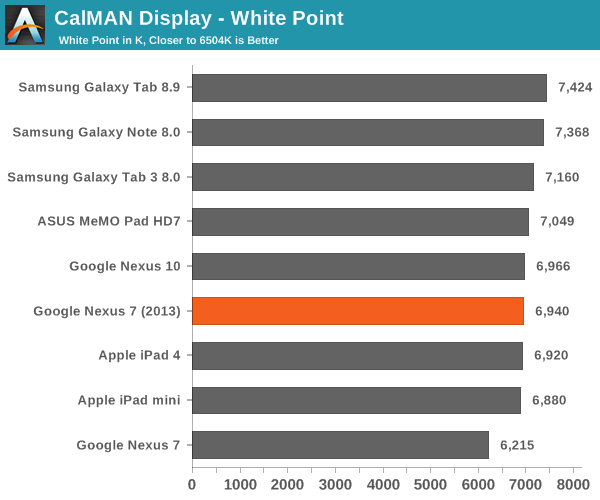
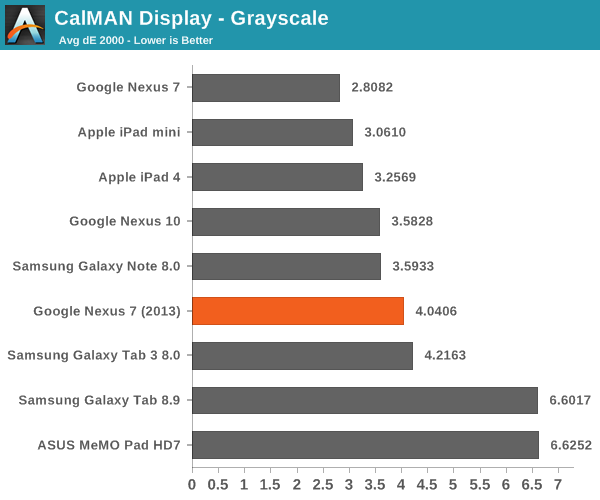
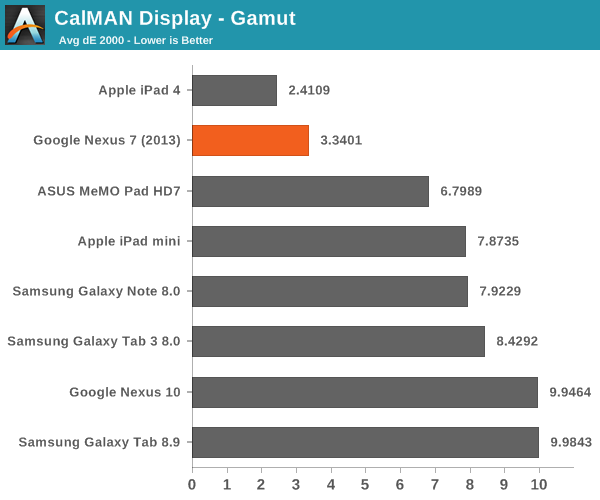
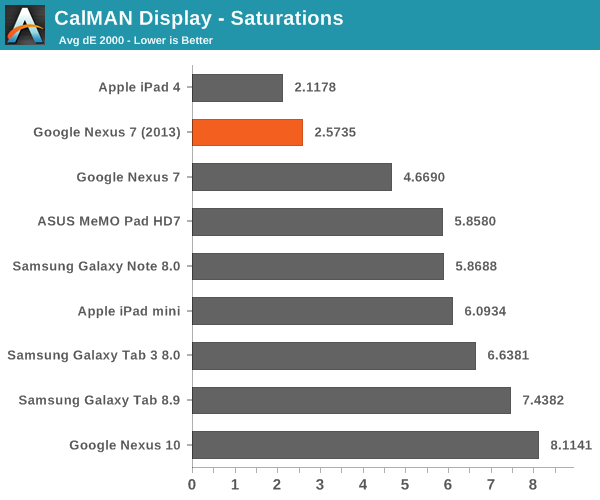
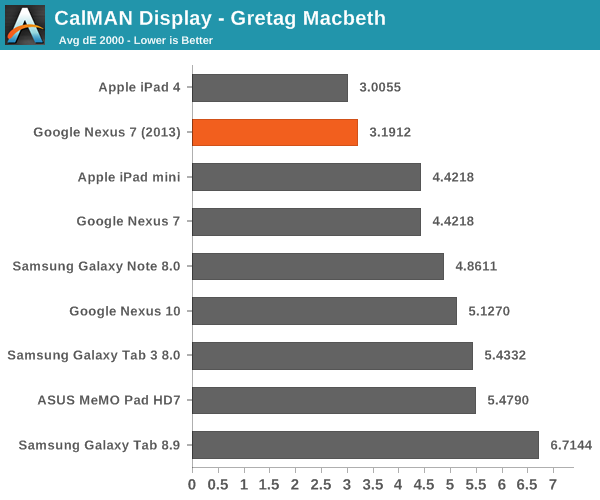
The new panel is also incredibly bright. I typically view 500 nits as the threshold for outdoor usability, and the new Nexus 7 definitely exceeds that threshold. The tablet will drink away all of your battery life if you leave it at this brightness setting indefinitely, but if you need to actually use your tablet outdoors for a while the Nexus 7 works.

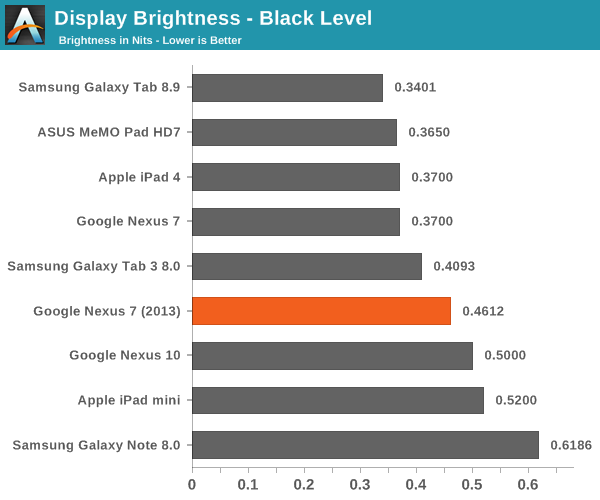
Black levels are a bit higher than on the original Nexus 7, but the resulting peak contrast ratio is still excellent:
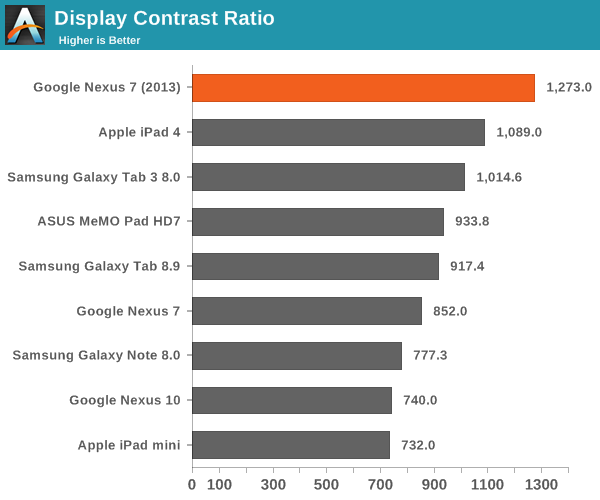
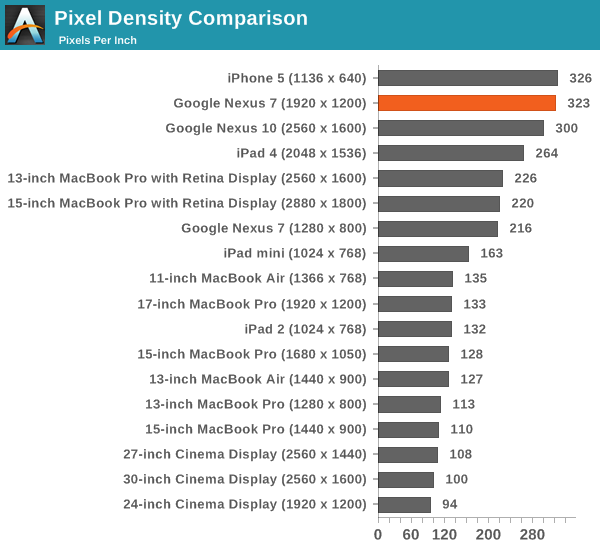
Pixel density shoots through the roof with the new Nexus 7 display as well. Brian was quick to point out that a major advantage of the Android platform is in its flexible resolution handling. The 1920 x 1200 panel presents itself as a 960 x 600 panel to web pages in Chrome, while other apps can use every last pixel for unique content (e.g. games).
The beauty of not having to double the original Nexus 7's resolution but instead settling on an in-between option like 1920 x 1200 is that Google could get away with a performance mainstream SoC instead of something ridiculously high-end.
The display looks great when viewing everything from photos and movies to web pages and eBooks. My only complaint about the Nexus 7's display is its size. A 7-inch tablet is almost pocketable (in fact I did carry it around in my pocket for a day), but the screen can feel a little cramped.


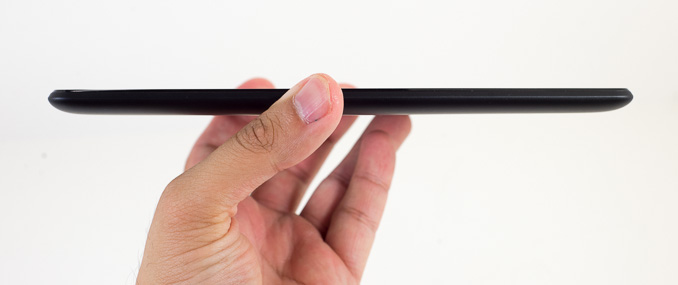
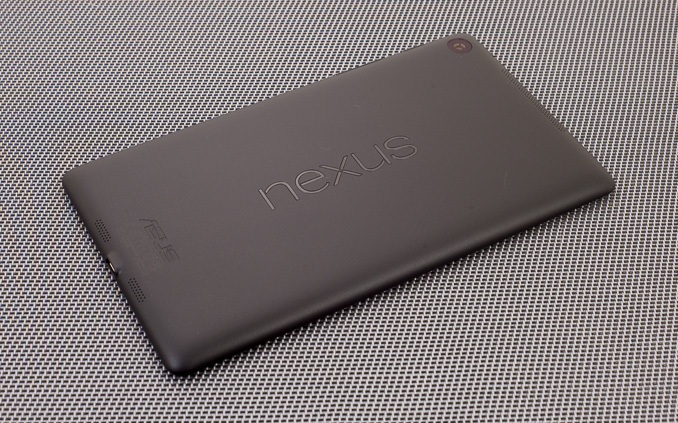
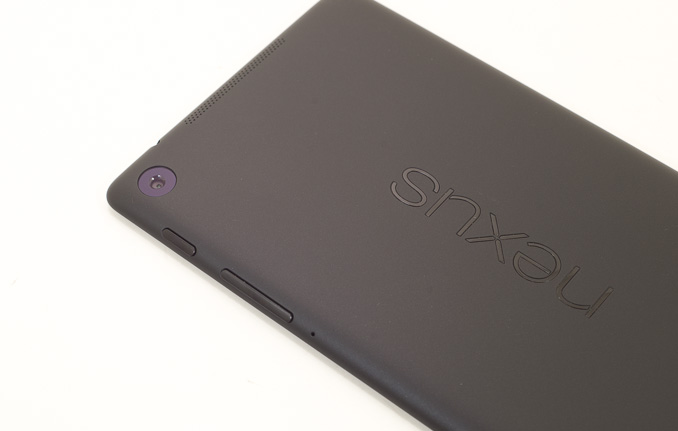


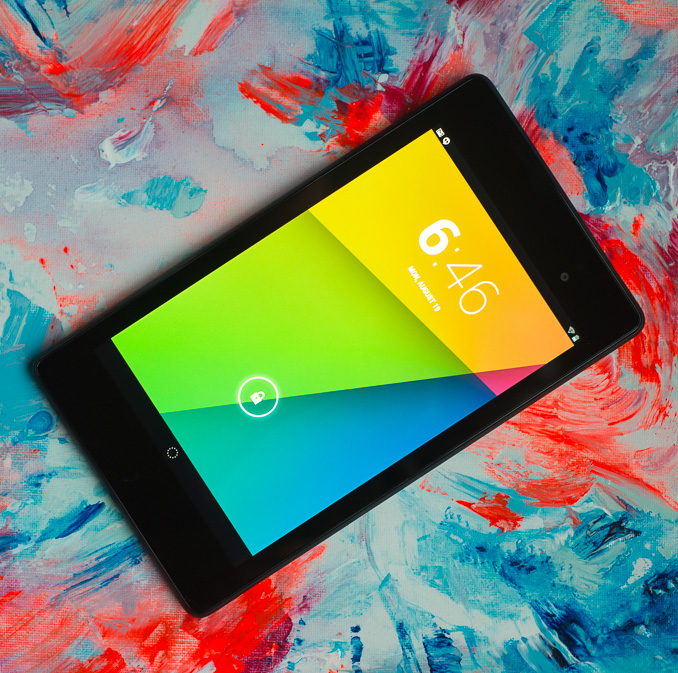
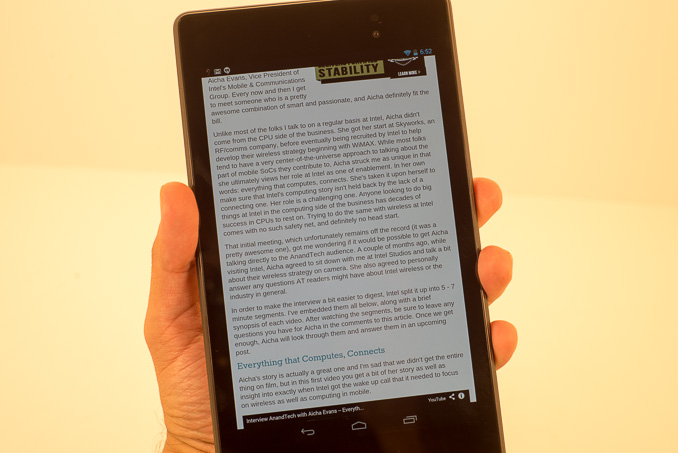
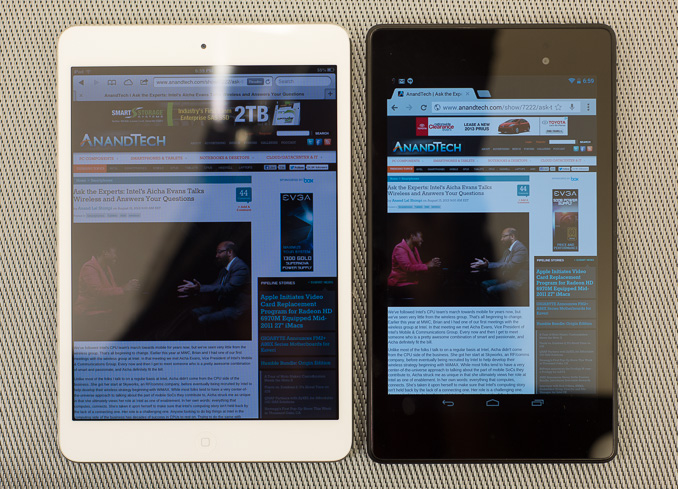








202 Comments
View All Comments
coldpower27 - Thursday, August 22, 2013 - link
Though bare in mind iPad mini is an old device due for a refresh in the Fall. A Retina display version, with a lower power A6X chip would do wonders. Unless you really love iOS, and the features Apple gives with their product, spec wise the Android tablet has them beat. But specs has never been all that is important when it came to these products. User experience is still key.looper - Thursday, August 22, 2013 - link
Coldpower27, I agree. Imagine the cost of a possible upcoming iPad Mini w/ Retina display.I wonder how much bigger one can make the default font size on the new Nexus7. My eyesight is not the best.
Oh, BTW, the word is "bear", not "bare"; and "specs *have* never been", not "has never been"... sorry.
mmarafie - Friday, August 23, 2013 - link
Yes of course :) When the new iPad mini is released that's when you'll see the Anand compare directly with the Nexus 7, and talk about how amazing the CPU/GPU in the mini are while again omitting mention of the price difference (probably double the cost of the N7) or any other strengths the N7 might have (higher ppi, more RAM, faster CPU etc).I'm still waiting for the review of the Nexus 10 which got released last year around the same time as iPad 4 (I own both), and the iPad 4 got the review in December while the Nexus 10 just got a preview.
weiran - Friday, August 23, 2013 - link
> any other strengths the N7 might have (higher ppi, more RAM, faster CPU etc).If a Retina iPad mini is released, it will have a higher PPI than this N7. And we all know that comparing specs in tablets is pointless if the comparison involves different OSes.
mmarafie - Friday, August 23, 2013 - link
Well define Retina please? If I'm not mistaken Apple considers 300 ppi and higher displays as Retina, yet the iPad 4 only has a 264 ppi display. The new Nexus 7 is over the 300 ppi magic number at 323. For the iPad mini to have a higher ppi than that it will need a higher resolution screen than the full HD one of the N7. It will need the same resolution as the iPad 4 (2048x1536) or higher. Its possible the new iPad mini will be released with a high res screen so we'll have to wait and see.kascollet - Saturday, August 24, 2013 - link
Retina is an Apple world, they can put it on whatever device they want but it always means :- pixels not visible at usual distance (more than 300 for a phone, more than 200 for a laptop, I between for a tablet...)
- high res is obtained by quadrupling the pixel count and thus conserving screen ratio and graphical elements size (makes all apps immediately compliant).
So if a Retina iPad Mini is made, it WILL feature a 2K x 1.5K resolution like the iPad 4.
retrospooty - Saturday, August 24, 2013 - link
"Retina is an Apple world, they can put it on whatever device they want but it always means :- pixels not visible at usual distance "
With a disclaimer - for 20/20 vision... Which is average eyesight, not above and not at all amongst the best. Most people with better eyesight may out around 400-450 DPI at 12 inches - some even higher.
Fri13 - Thursday, November 14, 2013 - link
20/20 is for normal eye sight, and it is the for most people.For most people (<90%) the 300 DPI at 20cm distance is more than enough, they can not see differences between that and 150 DPI without using magnification glass (lope actually) and compare exactly same content. With PPI there is no difference either unless you start looking trough very small details like in fonts from distance of 5-10cm and it isn't good for your eyes anyways. At normal viewing distance with tablet is 35-40cm.
When it comes to very good eye sight, last time what I read about the record (over decade ago) it was that a person could detect 6mm long string from distance of 2km, would be like display should have so high resolution that its density would be over 1.5 million on inch. But not even then a person with great eye sight could care less does display have a 150 PPI or 300 PPI.
I had once a friend and her eye sight was very good, she could read a normal news paper font (10-11 points) from distance of 20 meters. You couldn't not believe it without being there testing it. It was just jaw dropping that you could take any page and present it to her from 20m distance and she could read it a loud (we didn't test longer distance). But it was amazing how she could read a traffic signs text from few kilometer distance. It was like having a hawk what can talk to you.
The most important part in display pixel density is that font is rendered in manner it is clear to read. So you don't mistake letters and you don't need to spend much time quessing what letter is what.
Like how many is whining about 72-90 PPI in their workstation/laptop displays? They can read it perfectly fine, they don't find them disturbing to have much lower pixel density in their much bigger computer screen, but then they whine about smartphones and tablets if it is below 300 PPI.
retrospooty - Saturday, August 24, 2013 - link
"Well define Retina please?" - Retina is a marketing name Apple came up with for higher res screens. Apple fans, being a mostly non-technical bunch think it means something, but its arbitrary specs are just that... Arbitrary. 330+ isnt the end all be all of the DPI usefullness. The average eye cannot detect pixels at much higher DPI, but the other 1/2 of the world with above average eyesight can. IF you can see pixels, the higher hte better. If you cannot, save your $$$ and get something cheaper.abazigal - Saturday, August 24, 2013 - link
Retina is actually a combination of both PPI and distance of the screen from your eyes.Apple would probably explain that since users tend to hold the ipad further away from their eyes compared to a smartphone, the ipad4 can still be considered retina despite its lower PPI.
The ipad mini will likely have the same 2048x1536 display to maintain backwards compatibility with existing ipad apps. That gives it a PPI of 324 (same as iphone), putting it on par with the Nexus7.
My, hardware certainly has come a long way.